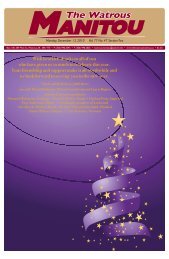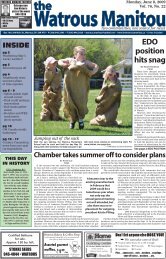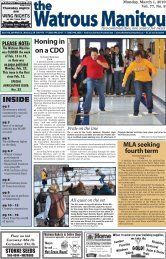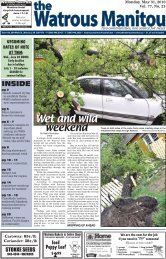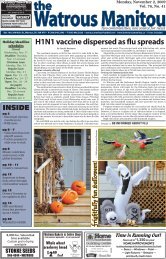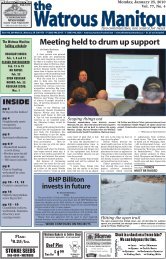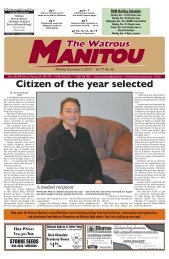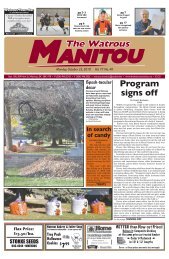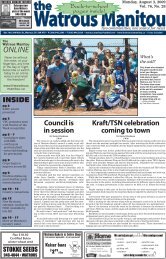June 14, 2010.pdf - Watrous Heritage Centre
June 14, 2010.pdf - Watrous Heritage Centre
June 14, 2010.pdf - Watrous Heritage Centre
You also want an ePaper? Increase the reach of your titles
YUMPU automatically turns print PDFs into web optimized ePapers that Google loves.
16 • MONDAY, JUNE <strong>14</strong>, 2010 THE WATROUS MANITOU<br />
By Daniel Bushman<br />
TWM<br />
Youth are the focus of<br />
a global demand that is<br />
being pushed to the forefront<br />
this week as the<br />
need for new blood is required<br />
around the world.<br />
Those donors along<br />
with others are being<br />
given a big thumbs up<br />
for their efforts during<br />
National Blood Donor<br />
Week, and World Blood<br />
Donor Day, both going<br />
this week.<br />
10063MF01<br />
Recognizing the efforts of local blood donors<br />
Manager of donor services<br />
for Saskatchewan<br />
Glenda Kolynchuk-Simpson<br />
is hoping that along<br />
with those already deciding<br />
to donate, more youth<br />
are encouraged to make<br />
that decision.<br />
Canadian Blood Services<br />
community development<br />
coordinator for<br />
rural areas Pat Young said<br />
as the nation’s population<br />
gets older, they need the<br />
youth to help fill in. “We<br />
need to get a lot of new<br />
young donors to keep the<br />
donor base up.”<br />
That was the case<br />
in <strong>Watrous</strong> last year as<br />
graduating student Melanie<br />
Deneiko took on<br />
the task of getting more<br />
people to donate. A program<br />
called Assignment:<br />
saving lives is offered by<br />
Canadian Blood Services<br />
with an opportunity not<br />
only to collect blood but<br />
also to have a chance to<br />
win a bursary for postsecondary<br />
education.<br />
Young said Deneiko<br />
signed up for the program<br />
and had to recruit<br />
a minimum of 25 blood<br />
donors during the summer<br />
months and have<br />
them donate. Deneiko<br />
was able to bring in current<br />
donors, new donors<br />
and people who had previously<br />
donated but had not<br />
recently given blood.<br />
Because of that effort,<br />
she was entered in for a<br />
bursary and later became<br />
a recipient of one.<br />
“It is very important.<br />
She brought in people and<br />
helped to meet the quota.”<br />
In fact, CBS had over 100<br />
per cent collection during<br />
that time.<br />
“It is an incentive to<br />
get young people to come<br />
out too.”<br />
Young said another initiative<br />
is available this<br />
year and that is to bleed<br />
green. Donors who attend<br />
clinics like the ones that<br />
will be held in <strong>Watrous</strong><br />
Aug. 3 and then again Oct.<br />
27 can have their name entered<br />
in to win Saskatchewan<br />
Roughrider tickets.<br />
With the generation<br />
shift, a demographic<br />
movement will take place<br />
that will have a two-fold<br />
effect on the blood supply:<br />
more blood will be required<br />
and fewer donors<br />
will be available.<br />
Some of the most loyal<br />
donors, according to Canadian<br />
Blood Services, are<br />
those aged 45 to 54 and<br />
last year the average age<br />
of a donor was 41. Donors<br />
older than 50 accounted<br />
for 30 per cent of all whole<br />
blood donations.<br />
While people can begin<br />
donating blood when they<br />
turn 17, on average, that<br />
youth category donates<br />
1.62 times a year compared<br />
to 2.18 times for<br />
older groups.<br />
Last year 5.3 per cent of<br />
eligible 17 to 24 year olds<br />
donated blood compared<br />
to about 3.4 per cent of<br />
the overall eligible population<br />
in Canada.<br />
Of the over 422,000<br />
donors in the country last<br />
year, more than 85,500<br />
were aged 17 to 24 and account<br />
for 20 per cent of<br />
the donors in the country.<br />
Young said the idea is<br />
to get youth interested in<br />
donating when they are in<br />
high school. As students<br />
leave for post-secondary<br />
school, they can donate<br />
there and then when they<br />
return to small towns it<br />
is almost like coming full<br />
circle.<br />
Kolynchuk-Simpson<br />
said, “National Blood<br />
Donor Week is our opportunity<br />
to show appreciation<br />
for the generous Canadians<br />
who donate blood,<br />
plasma, platelets and<br />
stem cells, and to let them<br />
know how much their donation<br />
matters.”<br />
On a more global picture,<br />
over 80 million units<br />
of blood are donated<br />
every year, with just 38<br />
per cent being collected<br />
in developing countries<br />
where 82 per cent of the<br />
global population live.<br />
World Blood Donor Day,<br />
which takes place today<br />
(<strong>June</strong> <strong>14</strong>), has been dedicated<br />
to those who voluntarily<br />
donate blood. Like<br />
National Blood Donor<br />
Week, it aims to recognize<br />
voluntary blood donors<br />
who are the foundation of<br />
a safe blood supply.<br />
The day also coincides<br />
with the birth date of<br />
Karl Landsteiner, a pioneer<br />
of transfusion<br />
medicine. This year, Barcelona,<br />
Spain hosts the<br />
world event.<br />
Between National<br />
Blood Donor Week and the<br />
end of August, Canadian<br />
Blood Services needs<br />
23,174 donors to give blood<br />
in the province.<br />
The blood is used every<br />
day to treat patients with<br />
bleeding disorders, individuals<br />
undergoing<br />
surgery, transplant recipients,<br />
cancer patients,<br />
newborn babies, trauma<br />
patients such as motor<br />
collision victims and<br />
others.



